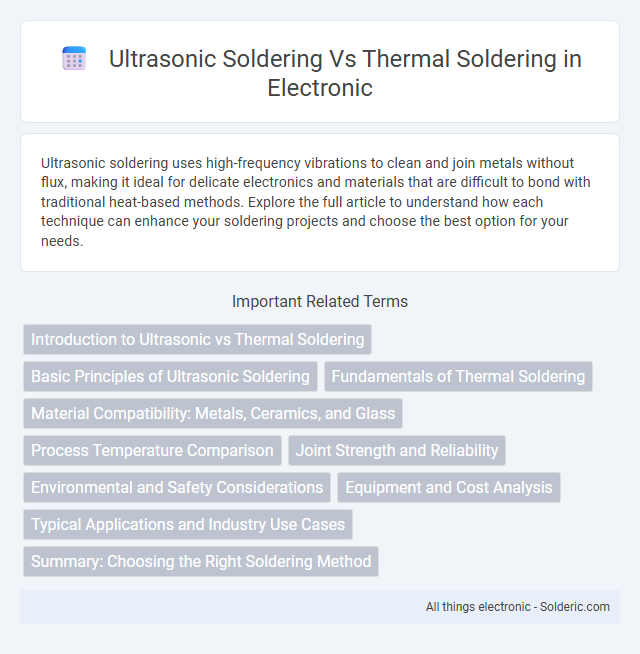Ultrasonic soldering uses high-frequency vibrations to clean and join metals without flux, making it ideal for delicate electronics and materials that are difficult to bond with traditional heat-based methods. Explore the full article to understand how each technique can enhance your soldering projects and choose the best option for your needs.
Comparison Table
| Feature | Ultrasonic Soldering | Thermal Soldering |
|---|---|---|
| Process | Uses high-frequency ultrasonic vibrations to join metals without flux | Uses direct heat to melt solder for joining metals |
| Flux Requirement | Flux-free soldering | Requires flux for effective soldering |
| Temperature Range | Lower temperature (typically 200-350degC) | Higher temperature (typically 300-400degC) |
| Material Compatibility | Effective on difficult-to-solder metals like aluminum, stainless steel | Best for common metals like copper, brass |
| Oxide Removal | Ultrasonic vibrations remove oxides mechanically | Depends on flux to remove oxides chemically |
| Joint Quality | Strong, clean joints with minimal contamination | Good joints but may have flux residues |
| Applications | Electronics, aerospace, medical devices requiring high-quality joints | General electronics, plumbing, and metalwork |
| Equipment Cost | Higher initial cost due to ultrasonic generator | Lower cost, simpler equipment |
| Environmental Impact | Eco-friendly, no harmful flux residues | Flux fumes and residues may require ventilation |
Introduction to Ultrasonic vs Thermal Soldering
Ultrasonic soldering uses high-frequency ultrasonic vibrations to create strong, oxide-free metal joints without the need for flux, making it ideal for bonding difficult-to-solder materials like ceramics and glass. Thermal soldering relies on direct heat application to melt solder and form connections, commonly used in traditional electronics and metalwork requiring precise temperature control. Ultrasonic soldering offers enhanced bond reliability and cleaner joints compared to thermal soldering, especially on dissimilar or non-metallic surfaces.
Basic Principles of Ultrasonic Soldering
Ultrasonic soldering utilizes high-frequency ultrasonic vibrations to create a strong bond between materials without the need for flux, effectively cleaning surfaces and enhancing wetting. This technique employs a sonotrode to transmit ultrasonic energy, breaking oxide layers on challenging substrates such as ceramics and glass. Thermal soldering, in contrast, relies solely on heat to melt solder and create joints, often requiring flux to remove oxides and improve adhesion.
Fundamentals of Thermal Soldering
Thermal soldering relies on direct heat transfer to melt solder and join components, utilizing temperatures typically between 180degC and 250degC depending on the solder alloy. This method ensures strong mechanical bonds by creating metallurgical connections through the diffusion of solder and substrate metals. Understanding the specific thermal profiles and heating techniques is crucial for optimizing joint quality and preventing damage to sensitive components during your electronic assembly process.
Material Compatibility: Metals, Ceramics, and Glass
Ultrasonic soldering excels in joining dissimilar materials such as metals, ceramics, and glass due to its ability to clean oxide layers and activate surfaces without flux, enabling strong, reliable bonds on non-metallic substrates. Thermal soldering typically performs well with metals but struggles with ceramics and glass because high temperatures can cause damage or poor adhesion, and flux alone cannot effectively address surface incompatibilities. For applications requiring metal-to-ceramic or metal-to-glass joints, ultrasonic soldering offers superior material compatibility and joint integrity compared to conventional thermal soldering methods.
Process Temperature Comparison
Ultrasonic soldering typically operates at lower temperatures ranging from 250degC to 350degC, enabling soldering of temperature-sensitive materials without thermal degradation. Thermal soldering requires higher temperatures, often exceeding 400degC, which can cause damage to delicate components or substrates. The lower process temperature of ultrasonic soldering enhances compatibility with sensitive electronics and reduces thermal stress during the joining process.
Joint Strength and Reliability
Ultrasonic soldering creates stronger and more reliable joints by using high-frequency vibrations that clean and activate the metal surfaces without flux, resulting in enhanced wetting and metallurgical bonding. Thermal soldering relies on heat alone, which may cause oxidation and weaker adhesion, leading to potential joint failures over time. Studies show ultrasonic solder joints exhibit superior mechanical strength and improved resistance to thermal cycling and environmental stress compared to traditional thermal soldered joints.
Environmental and Safety Considerations
Ultrasonic soldering reduces the need for flux, minimizing harmful chemical emissions and lowering environmental impact compared to traditional thermal soldering methods. This technique operates at lower temperatures, decreasing the risk of burns and toxic smoke, thereby enhancing workplace safety. Your choice of ultrasonic soldering can promote a safer environment with less hazardous waste and improved air quality.
Equipment and Cost Analysis
Ultrasonic soldering equipment typically involves high-frequency ultrasonic generators and specialized soldering irons, which contribute to higher initial investment costs compared to conventional thermal soldering tools that use simple heating elements. Maintenance expenses for ultrasonic soldering may increase due to the complexity of ultrasonic transducers and their sensitivity to wear. Despite the greater upfront and upkeep costs, ultrasonic soldering provides enhanced precision and is ideal for bonding dissimilar or heat-sensitive materials, potentially reducing rework costs in specialized applications.
Typical Applications and Industry Use Cases
Ultrasonic soldering is extensively used in electronics manufacturing for joining dissimilar metals such as glass-to-metal or ceramics, ideal for precision applications in aerospace, medical devices, and automotive sensors where traditional flux-based soldering fails. Thermal soldering dominates printed circuit board (PCB) assembly and mass production industries due to its efficiency in melting solder alloys for connecting metallic components in consumer electronics, telecommunications, and PCB-based automotive systems. Industries requiring high reliability in miniaturized, heat-sensitive components prefer ultrasonic soldering to avoid thermal damage while ensuring strong metallurgical bonds.
Summary: Choosing the Right Soldering Method
Ultrasonic soldering uses high-frequency vibrations to join materials without flux, ideal for bonding difficult metals and delicate components, while thermal soldering relies on direct heat application, suitable for conventional electronics assembly. Your choice depends on the specific materials, thermal sensitivity, and precision required in your project. Selecting the right soldering method ensures optimal joint strength, reliability, and efficiency in manufacturing or repair tasks.
ultrasonic soldering vs thermal soldering Infographic

 solderic.com
solderic.com